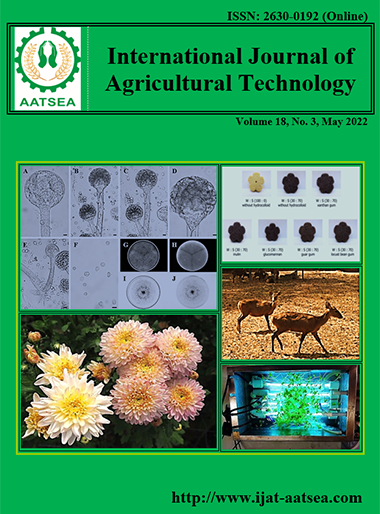Composting of boiler-ash and biogas-sludge from the palm oil industry for using as plantlet growing media
Main Article Content
Abstract
Agricultural organic waste is increasing yearly. In Thailand, the palm oil industry generates high amounts of waste 13.71 million ton/year, mainly as boiler-ash and biogas-sludge. This study focused on the basic properties of boiler-ash and biogas-sludge from the palm oil industry after composting and their possible use as growing media for lettuce. Boiler-ash and biogas-sludge from the palm oil industry were pre-treated (composting) and after that evaluated as growing media in comparison with peatmoss under pot experiment conditions. Under the pre-treatment experiment, the results showed that the type of materials affected the pH, EC, OM, total N and the C:N ratio (P<0.05). The pre-treatment method was affected the pH and EC (P<0.05). The type of growing media and porous materials affected germination percentage, germination index, shoot length, and shoot fresh and dry weight (P<0.01). Interaction between the type of treated materials and porous materials affected germination percentage, germination index, shoot length, root length, and shoot fresh and dry weight (P<0.05). The best material was boiler-ash compost with perlite as the porous material which gave 92.6% germination, 23.05 germination index, 39.10 mm in shoot length, 28.67 mm in root length, 0.2 g shoot fw/plant, and 0.0397 g shoot dw/plant but these results were not statistically different from undisturbed boiler-ash with perlite as the porous material. Therefore, boiler-ash compost and boiler-ash left for 90 days were recommended to use as growing media
Article Details

This work is licensed under a Creative Commons Attribution-NonCommercial-NoDerivatives 4.0 International License.
References
AOSA. (1983). Seed vigor testing handbook. Contribution no. 32. Assoc Officers. Seed Analyst.
Adediran, J. A. (2005). Growth of tomato and lettuce seedlings in soilless media. Journal of Vegetable Science, 11:5-15.
Brechner, M., Both, A. J. and Staff, C. E. A. (2013). Hydroponic lettuce handbook. Cornell Controlled Environment Agriculture, Ithaca, NY.
Charoensri, K., Wisawapipat, W., Darunsontaya, T. and Prakongkep, N. (2017). Effects of oil palm–derived biochar on plant nutrient availability and phosphorus solubility in an acid sulfate paddy soil. Agricultural Sciences, 48:270-28.
Chinakwe, E. C., Ibekwe, V. I., Ofoh, M. C., Nwogwugwu, N. U., Adeleye, S. A., Chinakwe, P. O., Nwachukwu, I. N. and Ihejirika, C. E. (2019). Effect of temperature changes on the bacterial and fungal succession patterns during composting of some organic wastes in greenhouse. Journal of Advances in Microbiology, 15:1-10.
Francou, C., Poitrenaud, M. and Houot, S. (2005). Stabilization of organic matter during composting: Influence of process and feedstocks. Journal Compost Science and Utilization, 13:72-83.
Gawankar, M. S., Haldankar, P. M., Haldavanekar, P. C., Salvi, B. R. and Jamadagni, B. M. (2019). Studies on seed germination and seedling growth in Jackfruit (Artocarpus heterophyllus Lam.) as influenced by media. International Journal of Chemical Studies, 7:1699-1705.
Gayasinghe, G. Y., Arachchi, I. D L. and Tokashiki, Y. (2010). Evaluation of containerized substrates developed from cattle manure compost and synthetic aggregates for ornamental plant production as a peat alternative. Resources Conservation and Recycling, 54:1412-1418.
Gomah, H. H., Ahmed, M. M., Abdalla, R. M., Farghy, A. Kh. and Eissa, M. A. (2020). Utilization of some organic wastes as growing media for lettuce (Lactuca sativa L.) plants. Journal of Plant Nutrition, 43:2092-2105.
ISTA (2013). International rules for seed testing, Edition 2003, International Seed Testing Association, Bassersdorf, Switzerland.
Kangsopa, J. and Siri, B. (2017). Seed germination and seedling growth of lettuce after seed pelleting with zinc. Khon Kaen Agriculture Journal, 45:553-560.
Khan, M. A. I., Ueno, K., Horimoto, S., Komai, F., Tanaka, K. and Ono, Y. (2009). Physicochemical, including spectroscopic and biological analyses during composting of green tea waste and rice bran. Biology and Fertility of Soils, 45:305-313.
Keawmorakot, T. Onthong, J. and Pengnoo, A. (2013). Nutrient compositions and release of shallot waste, goat dung and bone meal. Journal of Yala Rajabhat University, 8:131-145.
Marchiol, L., Mondini, C., Leita, L. and Zerbi, G. (2002). Effects of municipal waste leachate on seed germination in soil-compost mixtures. Restoration Ecology, 7:155-161.
Nesse, A.S., Sogn, T., Børresen, T. and Foereid, B. (2018). Peat replacement in horticultural growth media: The adequacy of coir, paper sludge and biogas digestate as growth medium constituents for tomato (Solanum lycopersicum L.) and lettuce (Lactuca sativa L.). Acta Agriculturae Scandinavica, Section B — Soil and Plant Science, 69:287-294.
Roca-Pérez, L., Martínez, C., Marcilla, P. and Boluda, R. (2009) Composting rice straw withsewage sludge and compost effects on the soil–plant system. Chemosphere, 75:781-787.
Samarakoon, U.C., Fyffe, C., Bale, J., Ling, P., Basnagala, S., Donley, N. and Altland, J. (2019). Effect of electrical conductivity on the productivity and nutrient uptake of Lactuca sativa L. grown using nutrient film technique (NFT). Acta Horticulturae, 1266:137-144.
Samarakoon, U. C., Palmer, J., Ling, P. and Altland, J. (2020). Effects of electrical conductivity, pH, and foliar application of calcium chloride on yield and tipburn of Lactuca sativa grown using the nutrient–film technique. HortScience, 55:1265-1271.
Sapkota, S., Sapkota, S. and Liu, Z. (2019). Effects of nutrient composition and lettuce cultivar on crop production in hydroponic culture. Horticulturae, 5:3-8.
Singh, W. R., Das, A. and Kalamdhad, A. (2012). Composting of water hyacinth using a pilot scale rotary drum composter. Environmental Engineering Research, 17:69-75.
Sommer, S. G. (2001). Effect of composting on nutrient loss and nitrogen availability of cattle deep litter. European Journal of Agronomy, 14:123-133.
Tambone, F. and Adani, F. (2017). Nitrogen mineralization from digestate in comparison to sewage sludge, compost and urea in a laboratory incubated soil experiment. Journal of Plant Nutrition and Soil Science, 180:355-365.
Zakarya, I. A., Khalib, S. N. B. and Ramzi, N. M. (2019). Effect of pH, temperature and moisture content during composting of rice straw burning at different temperature with food waste and effective microorganisms. E3S Web of Conferences, 34.
Zhou, G. X., Zhang, J. B., Chen, L., Zhang C. Z. and Yu, Z. H. (2016). Temperature and straw quality regulate the microbial phospholipid fatty acid composition associated with straw decomposition. Pedosphere, 26:386-398.


